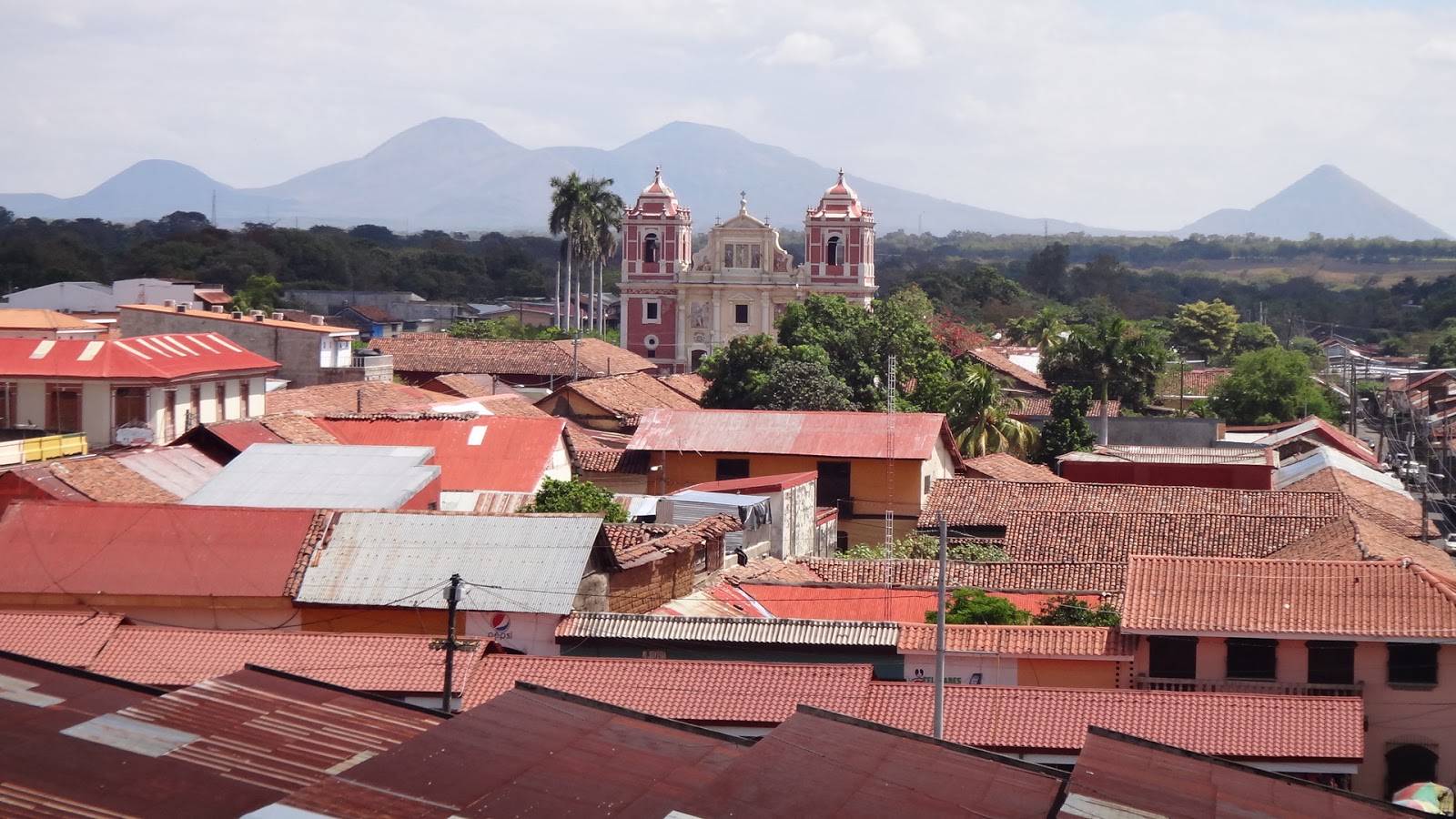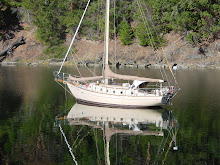Puesta del Sol, Nicaragua
We have just returned from a very relaxing 5 day, 4 night, adventure into historic Nicaragua. What made it so relaxing was that, instead of taking local buses and finding our own hotels, etc., we just booked the whole trip through Luis, a gentleman we met on our day-trip into Chinandega. Victor, our taxi driver, picked us up at the marina and delivered us, in air-conditioned comfort, to the city of Leon, then took us from Leon to Granada and finally back to the marina, with a couple of touristy, sight-seeing stops along the way. In each city, we had a 3-hour city tour and then had the rest of the time to ourselves - this worked great for us.
 First stop, just outside of Chinandega, was the world-famous Flor de Cana rum factory, home of the world's largest rum reserves - during the civil war they continued production and just stockpiled the product. Pretty cool, and they gave out free samples of their 18-year old slow-aged product.
First stop, just outside of Chinandega, was the world-famous Flor de Cana rum factory, home of the world's largest rum reserves - during the civil war they continued production and just stockpiled the product. Pretty cool, and they gave out free samples of their 18-year old slow-aged product. |
| The Rum Museum |
 The next day, on the tour of the colonial city of Leon, we were treated to a great view from the roof of the cathedral. As you can probably imagine, Susanne was ecstatic with the climb up there. This city is a little bit touristy, with the usual Spanish-designed central square and cathedral and lots of red-tiled roofs. Lots of small hostels and a variety of restaurants.
The next day, on the tour of the colonial city of Leon, we were treated to a great view from the roof of the cathedral. As you can probably imagine, Susanne was ecstatic with the climb up there. This city is a little bit touristy, with the usual Spanish-designed central square and cathedral and lots of red-tiled roofs. Lots of small hostels and a variety of restaurants. |
| Former prison overlooking the city of Leon |
 A lot of what we saw were reminders of the horrid recent history this country has had, with the civil war pitting the rebels against the USA-supported government; all forgiven and forgotten now of course. The main prisons and torture chambers are now museums.
A lot of what we saw were reminders of the horrid recent history this country has had, with the civil war pitting the rebels against the USA-supported government; all forgiven and forgotten now of course. The main prisons and torture chambers are now museums. After our two nights in Leon, Victor drove us to the other colonial city of Granada. Along the way, we stopped at the Masaya volcano where we enjoyed views of the steaming caldera. We did a short hike to the rim of one of the less active craters to get a better perspective - pretty impressive. Note: The whole Pacific side of Nicaragua has a row of smoking volcanoes, and can you guess where the bulk of the population is?
After our two nights in Leon, Victor drove us to the other colonial city of Granada. Along the way, we stopped at the Masaya volcano where we enjoyed views of the steaming caldera. We did a short hike to the rim of one of the less active craters to get a better perspective - pretty impressive. Note: The whole Pacific side of Nicaragua has a row of smoking volcanoes, and can you guess where the bulk of the population is? Granada is a much more touristy town than Leon, bursting with hotels and restaurants and a fleet of horse-drawn carriages to ferry the tourists around. Our city tour here included, inevitably, a ride in one such carriage. We saw the usual highlights like the various churches and museums, much more concerned here with the Spanish colonial period than the more recent wars. This whole town has been restored to a much higher degree than Leon. Of course, no tour would be complete without a climb up some high church tower to get an overall view of the city.
Granada is a much more touristy town than Leon, bursting with hotels and restaurants and a fleet of horse-drawn carriages to ferry the tourists around. Our city tour here included, inevitably, a ride in one such carriage. We saw the usual highlights like the various churches and museums, much more concerned here with the Spanish colonial period than the more recent wars. This whole town has been restored to a much higher degree than Leon. Of course, no tour would be complete without a climb up some high church tower to get an overall view of the city. One odd highlight was a visit to the local cemetery, with its incredibly ornate mausoleums. This is one place where you really can take it all with you.
One odd highlight was a visit to the local cemetery, with its incredibly ornate mausoleums. This is one place where you really can take it all with you. In the afternoon, we took a boat tour of the Granada peninsula and some of the 365 islands that populate this area of Lake Nicaragua. This was an incredibly interesting ride, viewing some very elegant vacation homes built by the rich and famous of Nicaragua, along with a glimpse of the local wildlife on the lake. One small island was populated with nothing but monkeys.
In the afternoon, we took a boat tour of the Granada peninsula and some of the 365 islands that populate this area of Lake Nicaragua. This was an incredibly interesting ride, viewing some very elegant vacation homes built by the rich and famous of Nicaragua, along with a glimpse of the local wildlife on the lake. One small island was populated with nothing but monkeys.While visiting a fortress, built in a bygone age to protect the city of Granada from pirates, we were directly exposed to the strong winds coming over this huge lake, from the Caribbean Sea (the lake is connected to the sea via a river to the east). This gave us a hint of what we will be facing as we try and sneak down the nearby coast at some point in the near future.
 |
| That volcano in the background is apparently the source of all of the islands now found in Lake Nicaragua |
Our last day in Granada saw the start of a huge festival of poetry that is held annually in the city. In the evening thousands of people swarmed the central square to hear poets recite their works. Not being fluent in Spanish, it was mostly lost for us.
 On the boat front, being in all these cities I was able to use the opportunity to find an adapter for my new temperature gauge. I installed this unit into the spot formerly used by the overtemp alarm, placing the head by the fuel dip-stick. In this way, I am able to check on the engine temperature by simply lifting the access hole for the dip-stick. I cannot use this temperature gauge to replace the original because it is a mechanical unit and it will not reach to the cockpit.
On the boat front, being in all these cities I was able to use the opportunity to find an adapter for my new temperature gauge. I installed this unit into the spot formerly used by the overtemp alarm, placing the head by the fuel dip-stick. In this way, I am able to check on the engine temperature by simply lifting the access hole for the dip-stick. I cannot use this temperature gauge to replace the original because it is a mechanical unit and it will not reach to the cockpit.I ran the engine up to temperature and under load for a half-hour and confirmed that the engine is just fine - it is NOT overheating at all. As I suspected, the problem is just a faulty alarm and an unreliable electronic gauge.
So now we just have to wait for a suitable weather window to allow us to move on past the raging papagayo winds that stand between us and Costa Rica...
 |
| Watching the winter Olympics during lunch in Leon |
{GMST}12|26.1726|N|86|52.5582|W|Leon, Nicaragua|Leon, Nicaragua{GEND}






















No comments:
Post a Comment